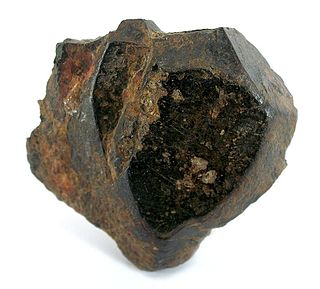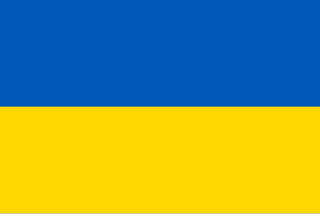
Ilmenite, also known as manaccanite, is a titanium-iron oxide mineral with the idealized formula FeTiO
3. It is a weakly magnetic black or steel-gray solid. From a commercial perspective, ilmenite is the most important ore of titanium. Ilmenite is the main source of titanium dioxide, which is used in paints, printing inks, fabrics, plastics, paper, sunscreen, food and cosmetics.

Mining in the United Kingdom produces a wide variety of fossil fuels, metals, and industrial minerals due to its complex geology. In 2013, there were over 2,000 active mines, quarries, and offshore drilling sites on the continental land mass of the United Kingdom producing £34bn of minerals and employing 36,000 people.

Metal production, in particular iron and steel industry, is the dominant heavy industry in Ukraine. Ukraine is the world's eighth largest producer and third largest exporter of iron and steel (2007). Ukrainian iron and steel industry accounts for around 2% of worldwide crude steel output, 5% to 6% of the national gross domestic product and 34% of Ukrainian export revenue. In 2007 it employed 420,000 people – 10% of industrial labor and 2% of the total workforce. It has the highest, by a wide margin, revealed comparative advantage of all branches of the Ukrainian economy. The industry peaked at 42.8 million tonnes in 2007 but has been gravely affected by the financial crisis of 2007–2010 and declined to 29.8 million tonnes in 2009.
The Muncelu Mic mine was a large open pit mine in the western of Romania in Hunedoara County, 16 km southeast of Simeria and 387 km north-west of the capital, Bucharest. Muncelu Mic represents one of the largest iron ore reserves in Romania having estimated reserves of 6.5 million tonnes of ore. When it was operational it produced around 200,000 tonnes of iron ore/year. The mine also has a gold and silver reserves of around 5.4 million tonnes grading 1g/t gold and 8g/t silver resulting 173,000 oz of gold and 1.38 million oz of silver.
The Ghelari mine was a large open pit, also an underground iron ore mine in the western of Romania in Hunedoara County, 20 km south-west of Hunedoara and 411 km north-west of the capital, Bucharest. Ghelari represents one of the largest iron ore reserves in Romania having estimated reserves of 14 million tonnes of ore. The mine produced around 200,000 tonnes of iron ore/year.
The Ocna de Fier mine is a large open pit mine in the western of Romania in Caraş-Severin County, 25 km west of Reşiţa and 511 km north-west of the capital, Bucharest. Ocna de Fier represents the largest iron ore reserves in Romania having estimated reserves of 200 million tonnes of ore grading 25% iron metal. The mine produces around 10,000 tonnes of iron ore/year.

The Paraburdoo mine is an iron ore mine located in the Pilbara region of Western Australia, near Paraburdoo.
Mining in North Korea is important to the country's economy. North Korea is naturally abundant in metals such as magnesite, zinc, tungsten, and iron; with magnesite resources of 6 billion tonnes, particularly in the Hamgyeong-do and Jagang-do provinces. However, often these cannot be mined due to the acute shortage of electricity in the country, as well as the lack of proper tools to mine these materials and an antiquated industrial base. Coal, iron ore, limestone, and magnesite deposits are larger than other mineral commodities. Mining joint ventures with other countries include China, Canada, Egypt, and South Korea.
The Gârliște mine is a large open pit mine in the western part of Romania in Goruia, Caraş-Severin County. Gârliște represents one of the largest iron ore reserves in Romania having estimated reserves of 3.6 million tonnes of ore.
The Shymanivske mine is a large iron mine located in central Ukraine in the Dnepr Oblast. Shymanivske represents one of the largest iron ore reserves in Ukraine and in the world having estimated reserves of 834 million tonnes of ore grading 32% iron metal.
The Ingulets mine is a large iron mine located in central Ukraine in the Dnipropetrovsk Oblast. Ingulets represents one of the largest iron ore reserves in Ukraine and in the world having estimated reserves of 937 million tonnes of ore grading 63.5% iron metal.
The Gorishne mine is a large iron mine located in central Ukraine in the Poltava Oblast. Gorishne represents one of the largest iron ore reserves in Ukraine and in the world having estimated reserves of 3.7 billion tonnes of ore grading 30% iron metal.
The Yeristovskoye mine is a large iron mine located in central Ukraine in the Poltava Oblast. Yeristovskoye represents one of the largest iron ore reserves in Ukraine and in the world having estimated reserves of 1.19 billion tonnes of ore grading 32% iron metal.
The Belanovskoye mine is a large iron mine located in central Ukraine in the Poltava Oblast. Belanovskoye represents one of the largest iron ore reserves in Ukraine and in the world having estimated reserves of 1.7 billion tonnes of ore grading 31% iron metal.
The Vasilievskoye mine is a large iron mine located in central Ukraine in the Poltava Oblast. Vasilievskoye represents one of the largest iron ore reserves in Ukraine and in the world having estimated reserves of 1.4 billion tonnes of ore grading 31% iron metal.
The Kharchenkovskoye mine is a large iron mine located in central Ukraine in the Poltava Oblast. Kharchenkovskoye represents one of the largest iron ore reserves in Ukraine and in the world having estimated reserves of 2.8 billion tonnes of ore grading 30% iron metal.
The Manuilovskoye mine is a large iron mine located in central Ukraine in the Poltava Oblast. Manuilovskoye represents one of the largest iron ore reserves in Ukraine and in the world. It is estimated that it has reserves of 3.5 billion tonnes of ore grading 30% iron metal.
The Brovarkovskoye mine is a large iron mine located in central Ukraine in the Poltava Oblast. Brovarkovskoye represents one of the largest iron ore reserves in Ukraine and in the world having estimated reserves of 4 billion tonnes of ore grading 30% iron metal.
The Cacova Ierii mine is a large open pit mine in the north-western of Romania in Cluj County. Cacova Ierii represents one of the largest iron ore reserves in Romania having estimated reserves of 16.6 million tonnes of ore grading 42% iron metal. The mine has the capability to produce around 415,000 tonnes of iron ore/year.
The Rudăria-Bănia mine is a large open pit mine in the south-western Romania in Caraș-Severin County. Rudăria-Bănia represents one of the largest iron ore reserves in Romania having estimated reserves of 70 million tonnes of ore grading 45% iron metal and 20% manganese metal. The mine has the capability to produce around 500,000 tonnes of iron ore/year.






